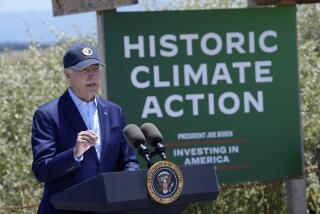Editorial: Câmon, President Biden: The U.S. needs ambitious clean-car rules to get to zero emissions faster

The U.N. climate conference in Glasgow, Scotland, has put a spotlight on the gulf between countriesâ pledges to cut planet-warming pollution and what they are actually doing right now.
Even if world leaders deliver on their promises, experts warn that a lack of concrete action between now and 2030 means emissions will still be nearly twice as high as whatâs needed to limit warming to 1.5 degrees Celsius and avoid catastrophic climate change.
But President Biden has the opportunity to make good on his words now and keep billions of tons of greenhouse gases out of the atmosphere, by strengthening the nationâs auto emissions standards.
His administration is on track to finalize new fuel economy and tailpipe emissions standards for passenger cars and trucks by the end of the year that would undo the rollbacks of President Trump. But the administrationâs proposal is filled with loopholes that critics say make it weaker than what automakers agreed to nearly a decade ago during the Obama administration. It risks falling short of Bidenâs own target of making half of all new vehicle sales zero-emission electric, plug-in hybrid or fuel cell by 2030.
Thatâs not good enough to meet this moment. We need real climate action to give us and future generations a chance at a livable future, not more hollow promises.
We have a lot of catching up to do after Trump curtailed improvements in fuel efficiency by gutting the biggest federal action to address climate change. Trumpâs weaker standards only required automakers to reach a fleetwide average of about 32 miles per gallon in real-world driving by 2026. Bidenâs proposal would boost those targets to around 38 mpg but would reduce pollution less than the original Obama-era standards, according to an analysis by the Union of Concerned Scientists.
But as destructive wildfires, deadly heat waves and other worsening climate impacts make painfully clear, we need to do better than just reversing Trumpâs attacks. Regulators have to move much faster, and set strong mandates that push automakers to build more electric vehicles sooner.
Transportation remains the nationâs largest source of climate-heating emissions, and experts say the production of gas-fueled cars needs to end by 2035 or earlier to avoid disastrous levels of warming. Electric vehicles still account for only 2% of new car sales nationwide.
To get on the right track, the Biden administration should choose the most stringent alternative possible and reduce emissions more steeply by 2026, as Californiaâs senators, the state Air Resources Board, environmental groups are urging. This approach would cut more pollution faster and remove credits and other loopholes that would otherwise allow automakers to keep producing more gas-guzzling trucks and SUVs.
In remarks Wednesday while attending the COP26 summit in Glasgow, U.S. Environmental Protection Agency Administrator Michael S. Regan said the final rule will be âmuch more aggressiveâ than what the agency released over the summer. The EPA confirmed that, in response to criticism, it strengthened the proposal before it was sent to the White House for review last week. Thatâs a welcome sign.
Major automakers, including GM and Ford, and dozens of national governments signed a pledge this week to âwork towardsâ making all new car sales zero-emission by 2040, and no later than 2035 in âleading markets.â But some of the worldâs biggest carmakers, including Toyota and Volkswagen, did not sign the pledge, nor did the United States, Japan and other leading car markets.
But as the world races to cut greenhouse gas emissions, we canât rely on pledges. The U.S. needs to show real leadership with tough, enforceable mandates that will push manufacturers, who have pledged to spend billions on factories to build electric vehicles, to deliver on those promises, and force companies that are lagging to get on board.
Itâs especially important that Biden take full advantage of his regulatory authority to cut pollution from vehicles because he is struggling to persuade Congress to back more comprehensive efforts to curtail fossil fuels, given the opposition of Republicans and key Democrats, including Sen. Joe Manchin III of West Virginia. The bipartisan infrastructure deal passed by Congress includes $7.5 billion to build up the nationâs electric vehicle charging network and the presidentâs Build Back Better Act, which is still being debated, would increase the electric vehicle tax credit to $12,500 for lower and middle-income families. Those measures would certainly help smooth the transition to electric cars, but incentives must be paired with strict mandates.
Once these rules are finalized, federal officials need to get working on even tougher standards for 2027 and beyond, as Biden has directed. The White House should also follow Californiaâs lead and set a date by which gas-powered vehicle sales will be phased out entirely.
Thereâs no time to waste. Every fraction of a degree of warming we can avoid and every gram of carbon dioxide we can keep out of the atmosphere gives us a better chance at a tolerable future.
More to Read
A cure for the common opinion
Get thought-provoking perspectives with our weekly newsletter.
You may occasionally receive promotional content from the Los Angeles Times.










